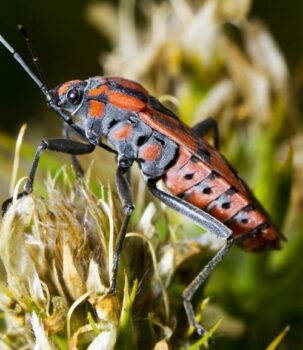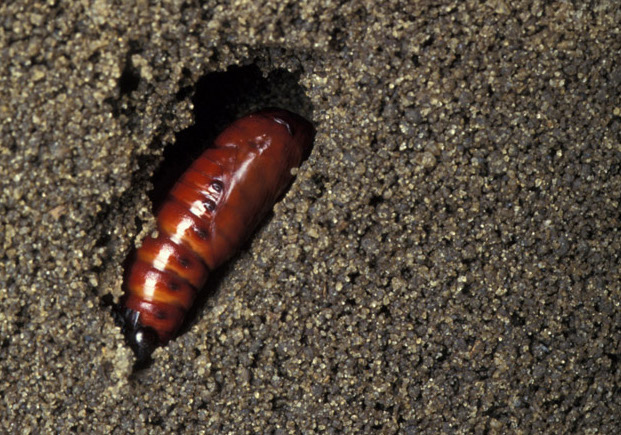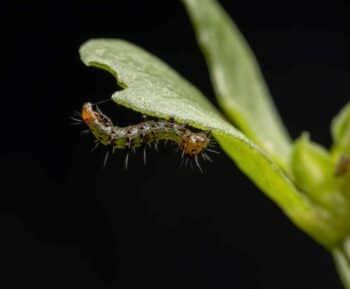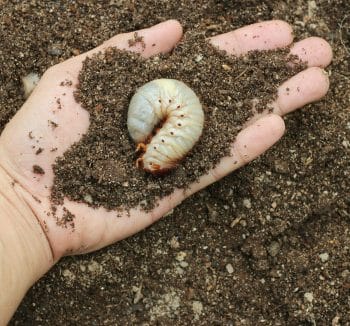Summertime in North Texas is full of extra things to consider regarding your lawn’s health: excessive heat, watering restrictions, even weeds and pests that specifically show up during the hottest months. Read about treatment for chinch bugs, armyworms, and grub worms
There are three troublesome insects that are most common in mid-summer through early fall, all of whom create similar-looking damage to your yard and garden: chinch bugs, armyworms, and grub worms.
Let’s take a look at the similarities and differences between these 3 pests, and then learn how to treat your lawn for them:
Chinch Bugs
Chinch bug infestations can be tricky to spot.
The bugs themselves are tiny, and the damage they inflict on your lawn looks very much like the aftermath of a summer drought. They create unsightly yellow patches that can sometimes be distinguished from drought or lawn disease if you pay attention to the shape and the patterning.
And we all know that you’ve gotta know what you’re dealing with in order to treat it effectively.
So how can you tell whether you’ve got chinch bugs or something else? Here’s what to keep in mind:
What Does the Damage Look Like?
The visible damage caused by chinch bugs actually has no discernible pattern. Unlike the circles commonly caused by fungal diseases, the signs of an infestation can appear random and unpredictable.
A well-irrigated yard with this type of damage is a good indicator that chinch bugs have been spreading through the soil. If you know your grass is getting adequate water but it still looks too dry, it may be time to further investigate.
Another indicator is how quickly the damage sets in. Drought and fungal diseases can take a while to take their toll, but the damage caused by chinch bugs only takes a couple of weeks to become visible.
What Do the Bugs Look Like?

Chinch bugs are very small black insects. Some have bright orange stripes with a broad upper thorax. Others are narrower with white wings and a white spot on their backs. They can sometimes be seen crawling along the surface of the damaged turf, but not always.
If you are suspicious that this is the cause of dried out grass patches in your yard, there’s a trick you can do to help verify. Put a bit of dirt into a can with water, and then stir it. This will cause the miniscule bugs to rise to the top.
What Else Should I Know?
Unfortunately, chinch bugs thrive on common North Texas turfs such as Zoysia and St. Augustine grass.
They cause damage by injecting their sharp beaks into the grass blades and sucking out the fluids and nutrients. This is why an infestation looks so similar to drought. The end result is the same: parched, brittle grass.
They are most likely to proliferate in the summer, and are relatively harmless in small numbers. Just like with grub worms, they only become problematic when the population explodes.
This can be caused by a lack of beneficial predator bugs (such as ladybugs) to keep their numbers in check. It can also be secondary to extreme heat or dry spells.
Armyworms
While the term “armyworm” refers to a variety of species in their larval stage, fall armyworms are specifically the larvae of the Fall Armyworm Moth. These are the armyworms we are most likely to see in the North Texas region.
These pests enjoy munching on all manner of foliage. Their meal consists of many forms of plant life, including crops, garden plants, and lawn turf.
While they adult version is harmless, it is the larvae- as with many lawn pests- that cause the real damage.
What Does the Damage Look Like?
The larvae will often leave foliage looking “ragged,” with occasional pollen-like dust around the base of a leaf.
Aside from this form of damage, the best way to identify the problem is to take a close look for the caterpillars themselves. Take a look around any plants or turf that appear to have been assaulted.
 What Do the Bugs Look Like?
What Do the Bugs Look Like?
Fall armyworms are brownish-green with vertical yellow and orange stripes. The stripes tend to be along the lower sides or underbelly of the worms.
They reach a length of about 2 inches, and spend much of their time above ground so they can feed on leaves, stems, etc.
Adult armyworm moths are mottled grey with white underwings, reaching a span of about 1.5 inches across. This wingspan makes them slightly larger than the common grey moths seen frequently in our region.
These insects tend to produce three to four generations per season. Even if you don’t see any damage in your grass or garden, be on the lookout for the worms if you begin to notice the adult moths around your yard.
What Else Should I Know?
While armyworms prefer bermuda grass and bahia grass, they feed on a broad variety of foliage. In fact, they can become a serious threat to farmers if significant crop damage occurs.
Agricultural reports of fall armyworm infestations tend to peak in late summer and early autumn, hence the “fall” in their name. Mid-July and August are definitely prime months to be on the lookout for them.
Longer grass tends to be a bit more vulnerable than turfs that get mowed more regularly. This is simply because the worms appear to feel safe to feed more consistently throughout the day in the midst of dense, lengthy blades.
Grub Worms
Despite their names, grub worms are actually the larvae of a few different kinds of beetles. Depending on the region you live in, this would include Japanese beetles, European chafers, and June bugs.
Indeed, grub worms are not actually a single species, but rather a common term for beetle larvae that damage grass by feeding on its roots.
What Does the Damage Look Like?
Large, amorphous expanses of dying grass that don’t respond well to watering, overseeding, etc. are a fairly sure sign of grub worms.
Grub worms typically hatch in the summer, and they reside largely beneath the surface of a yard’s soil. As they grow, they subsist mainly on roots, which is what makes them problematic.
The root damage can actually become so severe that you can pull entire patches of grass away from the topsoil!
If you see a patch of lawn that looks parched and ailing, then it’s time to investigate. The damaged patches turn brownish very quickly, and don’t show up in a set pattern like what is sometimes seen with fungal diseases.
 What Do the Bugs Look Like?
What Do the Bugs Look Like?
Grub worms have fat, C-shaped bodies that are typically milky in color. They grow to around 1-2 inches long and tend to have black or brownish heads.
As with the larvae of any insect that is common to your area, a few grub worms are nothing to worry about. But if you dig up a clump of dirt and find that you have more than 5 grub worms in 1 square foot of your lawn, you’re in trouble.
What Else Should I Know?
The trick is, other pests- such as chinch worms- can cause a similar pattern in affected grass. It is important to know how to determine what you are dealing with.
Different methods work better during specific times in the life cycle of an insect whose larvae fall into the grub worm category. While there are several insecticides that can cover a whole host of invasive pests, one good thing to know is that beneficial nematodes have been shown to be especially helpful in ridding your lawn of grub worms.
What Should I Do Now?
If an infestation of any of these 3 insects has been positively identified, the best course of action is consulting a professional landscaping company to conduct a pesticide treatment. Ryno Lawn Care is well-prepared for this task.
Most broad spectrum pesticides will do the job nicely, but 2 applications is often necessary. This is because the chemicals only kill live bugs but not the eggs. Thus, a second round is best practice to eradicate any bugs that have hatched since the initial treatment was applied.
Diatomaceous earth is also a good choice. It can effectively kill chinch bugs at any stage of development, as well as drying out their eggs.
Whether you use use chemical treatment, diatomaceous earth, or a combination, proper application is the key to success. Be sure you take a look at our Insect Control service page to find out how we can help.


 What Do the Bugs Look Like?
What Do the Bugs Look Like? What Do the Bugs Look Like?
What Do the Bugs Look Like?